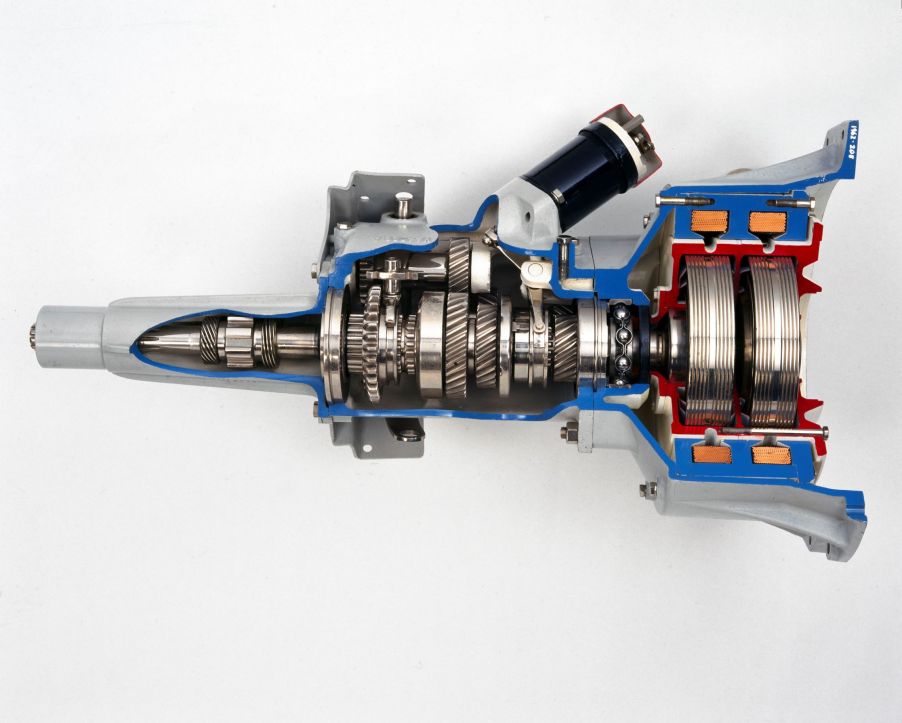
Does a Motorcycle Transmission Work Differently Than a Car One?
Despite their different designs, cars and motorcycles have the same basic mechanical components. They both have brake rotors, tires, as well as engines and/or electric motors. And helping send the engine/motor power to the wheels is a transmission. But at first glance, a motorcycle’s transmission doesn’t necessarily look like the one in a car. So, what makes them different?
What do a motorcycle transmission and a car transmission have in common?
Stripped down to their most basic elements, a motorcycle transmission and a car transmission are fairly similar. And they even evolved in much the same way.

The first motorcycles, from the board track racers to Pierce-Arrow’s 4-cylinder bikes, didn’t have transmissions. That was fine on flat ground, but it meant riders had to pedal to go over hills, Cycle World explains. So, as with cars, motorcycles gained transmissions with multiple gears and gear ratios. They let the engine do work more effectively, so your vehicle crawls uphill without stalling and speeds down the highway.
The earliest transmissions were all manuals and required the driver/rider to learn how to balance the throttle and clutch. In the case of a car, that was via various foot pedals and a hand-operated shifter. And for motorcycles into the 1940s and 50s, it was a similar situation, Revzilla and ItStillRuns report.

If you look at an Indian 101 Scout, for example, you’ll see a hand-operated shifter and a foot-operated clutch pedal. Even high-end bikes like the Brough-Superior SS100 and Crockers’ models used hand shifters. However, the now-ubiquitous foot-operated shifter originally debuted on the British Velocette KTT back in the late 1920s.
That foot-operated shifter, along with the hand-operated clutch lever, is arguably the biggest visual difference between motorcycle and car transmissions. But there are more differences under the surface.
What makes a motorcycle transmission different?

If you look at most manual car shifters, you’ll see the pattern of gears makes an ‘H’ shape. In the middle is neutral. And to go from one gear to the next, you move the shifter accordingly. However, that’s not quite how motorcycle transmissions or their shifters work.
True, they have all the same components—gears, input and output shafts, shift forks, etc., Cycle World reports. And they work in the same way. Clutch in, select the next gear, the gears mesh, clutch out while adding throttle, Cycle World and The Drive explain.

However, motorcycle shifters don’t have H-shaped gates. Instead, they have a toe shifter linked to a shift drum, Motorcyclist explains. Using the toe shifter, you shift down into 1st gear from neutral to get going. Then, when you have to shift into higher gears, you press the shifter up, passing through neutral and into 2nd and higher gears. I.e., a 6-speed motorcycle transmission is arranged, from bottom-to-top, 1-N-2-3-4-5-6. Heel-toe shifters separate the downshifting and upshifting into separate levers, but they work on the same principle, ItStillRuns explains.
This kind of transmission is called a sequential transmission, and it’s found in a few high-end race cars. But why do motorcycles use it? That’s partly due to regulations and partly based on rider needs and design restraints.
You really only shift into neutral a lot at low speeds, like when you’re sitting in city traffic. Therefore, it makes sense to put it between the lowest gears. And putting it below 1st raises the risk of accidentally shifting into neutral. Luckily, as with manual-equipped cars, there are safeguards in place to prevent unintentional shifting, Cycle World reports.
But why the sequential shifting? Partially because an H-pattern shifter on a bike would be essentially unusable. And partially because it has fewer parts and less weight, Road & Track reports.
Do all bikes have manuals?

Weight and space savings and simplicity are also why most motorcycles still use manual transmissions. Modern cars offer CVTs, dual-clutch automatics, and torque-converter automatics, but the vast majority of bikes still have manuals. Kawasaki’s even working on a manual-equipped electric bike.

However, you can buy motorcycles that don’t require mastering the clutch. The Honda Super Cub, for example, has a centrifugal clutch that doesn’t require a lever. You just let off the gas, select the next gear, and twist the throttle again. And many electric motorcycles just have a single-speed transmission; no shifting necessary. Plus, the idea of a CVT for bikes has been kicking around since before WWII, RideApart reports.

Speaking of Honda, it has arguably the most experience with motorcycle DCTs, RideApart reports. Both the Gold Wing touring bike and Africa Twin adventure bike are available with a DCT. And back in the 70s, it offered a semi-automatic transmission dubbed ‘Hondamatic,’ Cycle World reports
In the end, a motorcycle transmission does the same job as a car transmission. But the unique factors that go into designing and riding bikes means it takes a slightly different shape.
Follow more updates from MotorBiscuit on our Facebook page.


